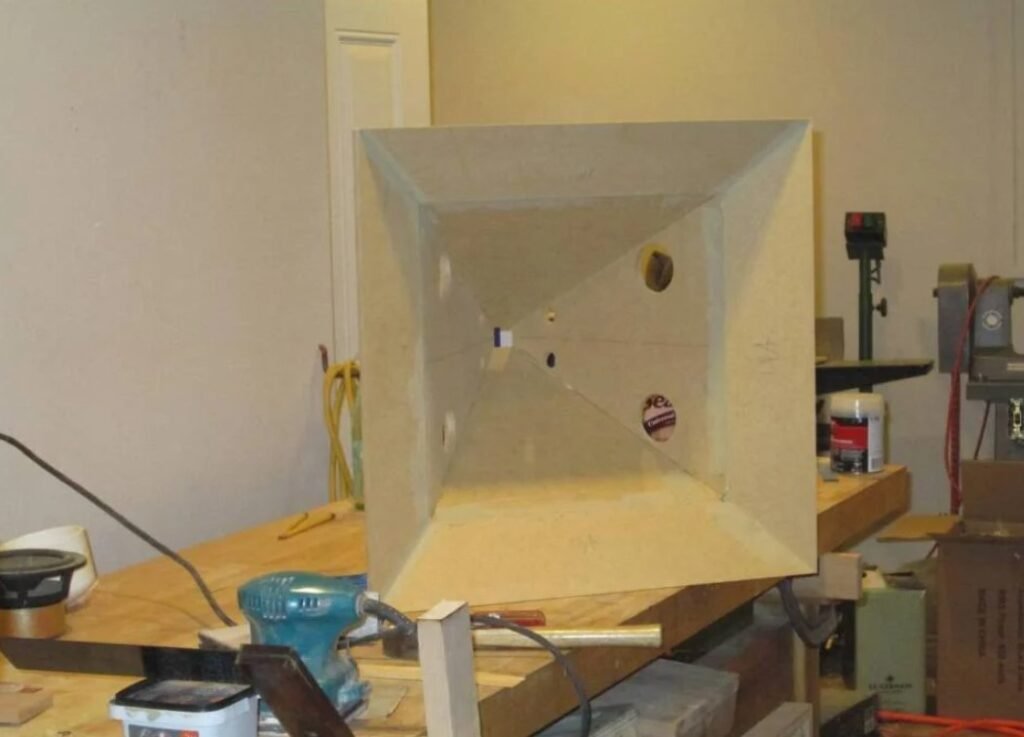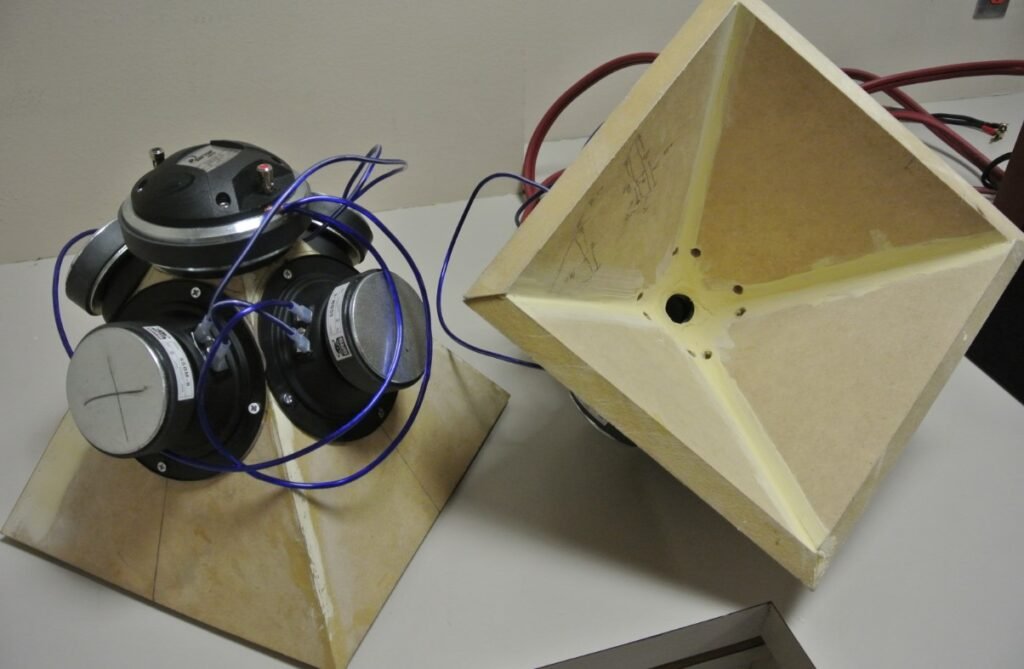In this article, we will learn all about the Synergy Horn Secondary Flare Angle and its importance to the Synergy Horn in different usages will be discussed. It has a great influence on the sound the loudspeaker produces. This is one dimension that is often overlooked, yet very much needed for the refurbishment of the sound system, about system efficiency, directivity, and frequency response, among others. Get to know all the aspects of the synergy horn secondary flare angle and advance your knowledge of a speaker’s design.
Synergy Horn Secondary Flare Angle
The secondary flare angle of the Synergy Horn is one of the most important design elements that affect sound distribution and sound reproduction performance. This angle determines how the sound waves fan out when leaving the horn and thus governs the directivity and coverage of the listening area. With this angle, sound engineers can enhance and glue a sound stage making it more realistic to the ears. In the end, the secondary flare angle enhances the performance of the Synergy Horn and therefore should be when dealing with quality sound systems.

What Is A Synergy Horn?
A synergy horn is a unique loudspeaker. It is a design that combines several drivers into one horn enclosure to create a coherent and efficient sound. This type of design usually integrates a high-frequency driver with one or more low-frequency drivers in the same cabinet so they perform acoustically in concert.
They are horn-shaped so they amplify sound output, which makes these speakers very efficient, and they can produce a much higher volume using much less power. They have controlled sound dispersion little reflections and off-axis noise, so synergy horns are very flexible and can be used for everything from home theaters to professional sound reinforcement.
How Does Synergy Horn Work?
The Synergy horns are a way to combine the outputs of numerous drivers, across several frequency stages, and then “knit” them together without a seam, in both amplitude and phase. The drivers are positioned at certain locations in the horn, enabling the blending of all frequencies as they leave the horn. This method reduces the occurrence of phase anomalies since sounds of varying frequencies reach the listener simultaneously. Thus, in addition to greater clarity and sound distribution, distortion is kept in check making it perfect for high-end audio systems.
How Does Synergy Horn Secondary Flare Angle Work?
The secondary flare angle of a synergy horn controls the expansion of the sound waves as they travel from the pharynx to the lips of the horn. That angle will cause the least distortion of sound waves, the sound will be as clear as possible at all frequencies. It changes the horn’s frequency response curve.

It allows low frequencies to be amplified without losing the quality of higher frequencies. Plus, the secondary flare angle allows for greater efficiency because it ensures maximum energy transfer in the form of sound so higher output with lower power. It also can control sound dispersion.
What Angle Is An Flare?
The normal flare angle is 45 degrees, but some specialized applications use a 37-degree flare. It is also known as a JIC (Joint Industry Council) flare. Key points about flare angles are as follows:
- The most common is the 45-degree flare. It’s miles used considerably in plumbing and HVAC structures.
- JIC flare: The 37-degree flare is industrial. It is known as a JIC flare.
How Do You Measure Flare Angle?
You can obtain a flare angle either from a flare gauge or from a protractor.
Pick major concepts
Find the area of the Horn where it is narrowest and the area where the Horn is widest
Establish the Horn Length
Establish the centerline distance from the throat to the mouth of the horn.
Establish the Diameter of the Mouth
At the widest section of the horn (the mouth), take the diameter measurement.
Compute the Angle of Flare
Using mathematics ground, it in the following Use of formulas: D= Thin Tapered Horn. L is the period of the horn.
Flare Angle=2×arctan (Horn Length / Radius at Mouth)
This is the angle of total flaring measured on the horn. The flare angle describes the axial extent from throat to mouth that the horn expands. This has an implication on the dispersion and spreading of the sound waves.
Mouth Flares And Their Effects On Horns
Mouth flares significantly affect the sound quality and efficiency of horn speakers. An appropriately designed mouth shape will minimize distortion caused by head reflections and edge diffraction of the horn, thus allowing for more reproduction of sound without colorations. Flare is also responsible for better low-frequency response as it helps in the gradual expansion of sound waves therefore better bass reproduction.

Wider flares cover more sound, it is good for larger areas, but narrow flares make the sound more concentrated. The mouth flares make it even more efficient, with more output for less power, due to better sound wave coupling. They also help cover frequency breaks in multiple horn systems, which can cause problems such as beaming and excessive focusing of sound. Mouth flares as a whole are a necessity to maximize sound clarity, bass response, and efficiency as a whole in horn speakers.
Any Proven Synergy Designs With Plans
Yes, there are a lot of known synergy horn designs out there with plans. it has been posted with the aid of audiophiles and experts alike. A common one is the Danley Synergy Horn. It is praised for its use in professional and home audio. The Danley designs are owned and not for public use, but some DIY synergy horn designs follow the same principles. For those who want to do it themselves. There are kits like the DIY Sound Group’s Synergy Horn Kits, which include plans and parts to build synergy horns. These “kits” provide tested designs, exact driver locations, horn flares, and cabinet dimensions that guarantee sound will be as good as possible.
Midranges For Synergy Horn
Midrange drivers in synergy horns play a significant role in maintaining the sound reproduction quality between 200Hz-2kHz. When picking these drivers, some aspects that require consideration are the dimension range of about 3 to 6.5 inches. For instance, smaller drivers are favored because of their ability to handle more high frequencies. Efficiency is another characteristic expressed in sensitivity, in this case, more than 90 dB to promote the matching of the horn output and power requirements.
Some typical examples include the B&C 5MDN38, which delivers good sensitivity and clarity, FaitalPRO 5FE120, which boasts good efficiency and range, and the Eminence Beta-8A, which offers high durability and good midrange. In synergy horn types of speaker systems, selecting the most appropriate midrange driver is critical in achieving good sound reproduction.
What Is DIY Synergy Horn?
DIY synergy horn is a type of speaker that uses multiple drivers in a single horn structure, and it has very high efficiency, very low distortion, and just sounds beautiful. A synergy horn employs an exact geometry of midrange and high-frequency drivers to create a congruent wavefront so that the drivers can work in phase with each other for the best possible sound.

For DIY enthusiasts, building a synergy horn offers the opportunity to customize the cabinet’s size, materials, and driver selection, allowing for a tailored design that meets individual audio preferences and fits specific room acoustics.
What Is Nearly Full-Range Multiple Entry Horns?
A Nearly Full-Range Multiple Entry Horn is a speaker design that uses multiple drivers (low, mid, and high frequency) within a single horn structure. This makes the horn almost cover the entire range of audio frequencies. They are placed at various stages within the horn to make sure they are in phase with each other and produce a smooth continuous sound. Some of the main advantages are a large frequency response, increased efficiency, and controlled directivity which makes it perfect for reproducing strong, undistorted audio over a large range.
Understanding Synergy Horns-Dayton And PRV
Synergy horns are just design and application, Dayton, PRV audio, and all that stuff good stuff in audio land. They both play a big part in the horn synergy idea, with their products providing the audiophile and professional the means to achieve that level of great sound through driver integration and the design of the horn itself.
Dayton Audio has a variety of synergy horn designs, with efficiency and clarity in mind. They have synergy horns designed to combine several drivers for continuous sound reproduction over different frequencies. The Dayton Synergy horn kits usually include plans, so it is more feasible for the home builder to construct speakers.
PRV Audio also manufactures some synergy horns focused on efficiency and audio quality. They like compression and multiple drivers to help spread the sound out more evenly and cut back on distortion. PRV’s synergy horns are found in professional and home audio systems and always provide the listener with great performance and crystal-clear sound.
What Is The Flare Angle Of A Pyramidal Horn Antenna?
The corresponding discrete lens is designed for a quick pyramidal horn with an aperture of 2.7λ 0 ×2.7λ zero and a flare angle of 97.5°. The horn pinnacle is only 1.24λ 0. The numbers show that the antenna’s aperture performance is 65% over a 16% bandwidth targeted at 4 GHz.

What Is The Flare Constant Of A Horn?
Exponential horns only apply when the flare constant is 1.0. In any case, where the flare constant is less than 1, the hyperbolic-exponential horn comes into play. The flare constant of a horn (usually k) is a dimensionless number that describes the rate at which the horn expands in cross-sectional area from the throat to the mouth. This is the mathematical definition of the change in the radius of the horn over the change in length, or simply how fast the horn is expanding.
Conclusion
The Synergy Horn Secondary Flare Angle is an important design factor that controls sound radiation pattern, efficiency, and articulation. You can minimize distortion, and improve the frequency response and overall sound quality by tuning this angle to its most efficient position. Anybody with high-end audio systems needs to know what the secondary flare angle does to achieve better sound performance.
People Also Ask
What is synergy in design?
Synergy is a term used in design, combining many components to work together, producing something cohesive and better than just the sum of its parts.
How do I choose a compression driver horn?
Select a compression driver horn according to your desired frequency response, sensitivity rating, and dispersion pattern. Ensure it is compatible with your speaker though, to get the best sound possible.
What is a horn driver speaker?
A horn driver speaker is a speaker that uses a horn to amplify and direct the sound, so the efficiency of the speaker is greatly improved as well as the clarity and projection of the sound, using only a small amount of power.
What are the basic compression settings?
The simplest compression settings are Threshold (where it starts to compress), Ratio (how much it compresses), Attack (how fast it kicks in), and Release (how fast it lets go).
What is the correct compression rate?
1 to 4:1 is common for vocals, while higher ratios like 6:1 or more are used for stronger dynamic control.
